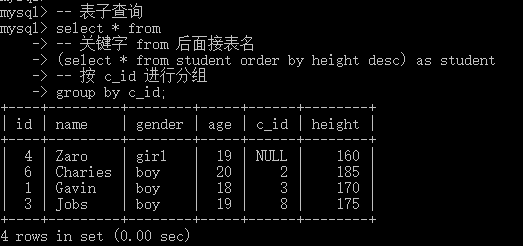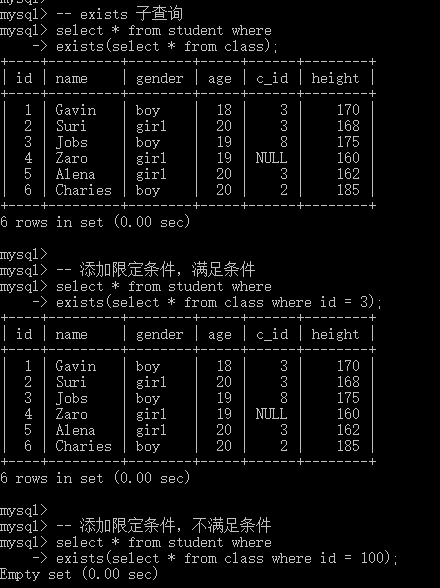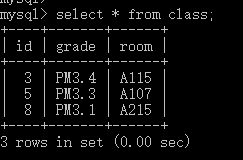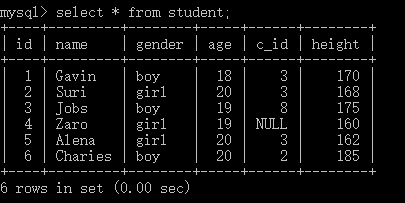子查询
子查询:sub query,查询是在某个查询结果之上进行的,一条select语句内部包含了另外一条select语句。
行子查询
行子查询,返回的结果可以使一行多列或者多行多列。
需求:查询学生表中,年龄最大且身高最高的学生。
思路:
- 先确定数据源,学生表。
select * from student where age = ? and height = ?;
- 然后确定最大年龄和最大身高。
select max(age), max(height) from student;
执行如下 SQL 语句,进行测试:
-- 列子查询
select * from student where
-- 其中,(age, height) 称之为行元素
(age, height) = (select max(age), max(height) from student);- 1
- 2
- 3
- 4
表子查询
表子查询,返回的结果是多行多列二维表(将子查询的结果当做二维表来使用),实际上,任何查询返回的结果都可以称之为二维表。
需求:找出每个班身高最高的学生。
思路:
- 先确定数据源,将学生按身高进行降序排序。
select * from student order by height desc;
- 从每个班级选出第一个学生。
select * from student group by c_id;
在这里,我们可能会有些疑问:为什么要将学生表降序排序?为什么从每个班级选出第一个学生就可以?这是因为group by(分组)只会取表中分组字段的第一条记录,而当我们将学生表按身高降序排序时,(每组)身高最高的学生就会出现在第一位。
执行如下 SQL 语句,进行测试:
-- 表子查询
select * from
-- 关键字 from 后面接表名
(select * from student order by height desc) as student
-- 按 c_id 进行分组
group by c_id;- 1
- 2
- 3
- 4
- 5
- 6
由上面的 SQL 语句可知,表子查询也是from子查询,即有select语句位于from之后。
exists子查询
exists:表示是否存在的意思,因此exists子查询就是用来判断某些条件是否满足(跨表),exists是接在where之后,其返回的结果为1或0,满足条件为1,反之为0.
需求:在班级存在的前提下,查询所有的学生。
思路:
- 先确定数据源。
select * from student where ?;
- 然后确定条件是否满足。
exists(select * from class);
执行如下 SQL 语句,进行测试:
-- exists 子查询
select * from student where
exists(select * from class);
-- 添加限定条件,满足条件
select * from student where
exists(select * from class where id = 3);
-- 添加限定条件,不满足条件
select * from student where
exists(select * from class where id = 100);- 1
- 2
- 3
- 4
- 5
- 6
- 7
- 8
- 9
- 10
- 11
至此,我们已经将子查询学习完啦!也许大家还会有些疑惑,那就是到底在什么时候用什么子查询?对于这个问题,我们不用过于纠结,因为这根本就是我们要用什么子查询的问题,而是根据实际需求,我们将查询返回的结果按形式命名的称呼而已。
查询class表:
查询student表:
温馨提示:符号[]括起来的内容,表示可选项;符号+,则表示连接的意思。




